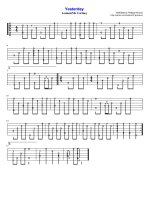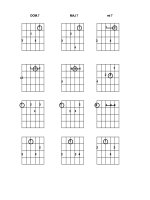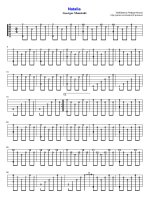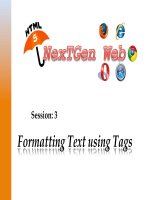Session 11 XP tủ tài liệu bách khoa
Bạn đang xem bản rút gọn của tài liệu. Xem và tải ngay bản đầy đủ của tài liệu tại đây (2.48 MB, 57 trang )
Fundamentals of Java
Describe Interface
Explain the purpose of interfaces
Explain implementation of multiple interfaces
Describe Abstraction
Explain Nested class
Explain Member class
Explain Local class
Explain Anonymous class
Describe Static nested class
© Aptech Ltd.
Interfaces and Nested Classes/Session 11
2
Java does not support multiple inheritance.
However, there are several cases when it becomes mandatory for an object to
inherit properties from multiple classes to avoid redundancy and complexity
in code.
For this purpose, Java provides a workaround in the form of interfaces.
Also, Java provides the concept of nested classes to make certain types of
programs easy to manage, more secure, and less complex.
© Aptech Ltd.
Interfaces and Nested Classes/Session 11
3
An interface in Java is a contract that specifies the standards to be followed by
the types that implement it.
The classes that accept the contract must abide by it.
An interface and a class are similar in the following ways:
An interface can contain multiple methods.
An interface is saved with a .java extension and the name of the file must match
with the name of the interface just as a Java class.
The bytecode of an interface is also saved in a .class file.
Interfaces are stored in packages and the bytecode file is stored in a directory
structure that matches the package name.
© Aptech Ltd.
Interfaces and Nested Classes/Session 11
4
An interface and a class differ in several ways as follows:
An interface
cannot be
instantiated.
An interface cannot have
constructors.
All the methods of an interface are
implicitly abstract.
The fields declared in an interface must be
both static and final.
Interface cannot have instance fields.
An interface is not extended but implemented by a class.
An interface can extend multiple interfaces.
© Aptech Ltd.
Interfaces and Nested Classes/Session 11
5
In several situations, it becomes necessary for different groups of developers to
agree to a ‘contract’ that specifies how their software interacts.
Each group should have the liberty to write their code in their desired manner
without having the knowledge of how the other groups are writing their code.
Java interfaces can be used for defining such contracts.
Interfaces do not belong to any class hierarchy, even though they work in
conjunction with classes.
Java does not permit multiple inheritance for which interfaces provide an
alternative.
In Java, a class can inherit from only one class but it can implement multiple
interfaces.
Therefore, objects of a class can have multiple types such as the type of their own
class as well as the types of the interfaces that the class implements.
© Aptech Ltd.
Interfaces and Nested Classes/Session 11
6
The syntax for declaring an interface is as follows:
Syntax
<visibility> interface <interface-name> extends <other-interfaces, … >
{
// declare constants
// declare abstract methods
}
where,
<visibility>: Indicates the access rights to the interface. Visibility of an
interface is always public.
<interface-name>: Indicates the name of the interface.
<other-interfaces>: List of interfaces that the current interface inherits from.
For example,
public interface Sample extends Interface1{
static final int someInteger;
public void someMethod();
}
© Aptech Ltd.
Interfaces and Nested Classes/Session 11
7
In Java, interface names are written in CamelCase, that is, first letter of each word is
capitalized.
Also, the name of the interface describes an operation that a class can perform. For
example,
interface Enumerable
interface Comparable
Some programmers prefix the letter ‘I’ with the interface name to distinguish
interfaces from classes. For example,
interface IEnumerable
interface Icomparable
Notice that the method declaration does not have any braces and is terminated with a
semicolon.
Also, the body of the interface contains only abstract methods and no concrete
method.
Since all methods in an interface are implicitly abstract, the abstract keyword is
not explicitly specified with the method signature.
© Aptech Ltd.
Interfaces and Nested Classes/Session 11
8
Consider the hierarchy of vehicles where IVehicle is the interface that declares the
methods which the implementing classes such as TwoWheeler, FourWheeler, and
so on can define.
To create a new interface in NetBeans IDE, right-click the package name and select
New → Java Interface as shown in the following figure:
© Aptech Ltd.
Interfaces and Nested Classes/Session 11
9
A dialog box appears where the user must provide a name for the interface and then,
click OK. This will create an interface with the specified name.
Following code snippet defines the interface, IVehicle:
package session11;
public interface IVehicle {
// Declare and initialize constant
static final String STATEID=”LA-09”; // variable to store state ID
/**
* Abstract method to start a vehicle
* @return void
*/
public void start();
/**
* Abstract method to accelerate a vehicle
* @param speed an integer variable storing speed
* @return void
*/
public void accelerate(int speed);
© Aptech Ltd.
Interfaces and Nested Classes/Session 11
10
/**
* Abstract method to apply a brake
* @return void
*/
public void brake();
/**
* Abstract method to stop a vehicle
* @return void
*/
public void stop();
}
The syntax to implement an interface is as follows:
Syntax
class <class-name> implements <Interface1>,…
{
// class members
// overridden abstract methods of the interface(s)
}
© Aptech Ltd.
Interfaces and Nested Classes/Session 11
11
Following code snippet defines the class TwoWheeler that implements the
IVehicle interface:
package session11;
class TwoWheeler implements IVehicle {
String ID; // variable to store vehicle ID
String type; // variable to store vehicle type
/**
* Parameterized constructor to initialize values based on user input
*
* @param ID a String variable storing vehicle ID
* @param type a String variable storing vehicle type
*/
public TwoWheeler(String ID, String type){
this.ID = ID;
this.type = type;
}
/**
* Overridden method, starts a vehicle
*
© Aptech Ltd.
Interfaces and Nested Classes/Session 11
12
* @return void
*/
@Override
public void start() {
System.out.println(“Starting the “+ type);
}
/**
* Overridden method, accelerates a vehicle
* @param speed an integer storing the speed
* @return void
*/
@Override
public void accelerate(int speed) {
System.out.println(“Accelerating at speed:”+speed+ “ kmph”);
}
/**
* Overridden method, applies brake to a vehicle
*
* @return void
© Aptech Ltd.
Interfaces and Nested Classes/Session 11
13
*/
@Override
public void brake() {
System.out.println(“Applying brakes”);
}
/**
* Overridden method, stops a vehicle
*
* @return void
*/
@Override
public void stop() {
System.out.println(“Stopping the “+ type);
}
/**
* Displays vehicle details
*
* @return void
*/
public void displayDetails(){
© Aptech Ltd.
Interfaces and Nested Classes/Session 11
14
System.out.println(“Vehicle No.: “+ STATEID+ “ “+ ID);
System.out.println(“Vehicle Type.: “+ type);
}
}
/**
* Define the class TestVehicle.java
*
*/
public class TestVehicle {
/**
* @param args the command line arguments
*/
public static void main(String[] args){
// Verify the number of command line arguments
if(args.length==3) {
// Instantiate the TwoWheeler class
TwoWheeler objBike = new TwoWheeler(args[0], args[1]);
© Aptech Ltd.
Interfaces and Nested Classes/Session 11
15
// Invoke the class methods
objBike.displayDetails();
objBike.start();
objBike.accelerate(Integer.parseInt(args[2]));
objBike.brake();
objBike.stop();
}
else {
System.out.println(“Usage: java TwoWheeler <ID> <Type> <Speed>”);
}
}
}
Following figure shows the output of the code when the user passes CS-2723 Bike
80 as command line arguments:
© Aptech Ltd.
Interfaces and Nested Classes/Session 11
16
Java does not support multiple inheritance of classes but allows implementing multiple
interfaces to simulate multiple inheritance.
To implement multiple interfaces, write the interface names after the implements
keyword separated by a comma.
For example,
public class Sample implements Interface1, Interaface2{
}
Following code snippet defines the interface IManufacturer:
package session11;
public interface IManufacturer {
/**
* Abstract method to add contact details
* @param detail a String variable storing manufacturer detail
* @return void
*/
public void addContact(String detail);
/**
* Abstract method to call the manufacturer
© Aptech Ltd.
Interfaces and Nested Classes/Session 11
17
* @param phone a String variable storing phone number
* @return void
*/
public void callManufacturer(String phone);
/**
* Abstract method to make payment
* @param amount a float variable storing amount
* @return void
*/
public void makePayment(float amount);
}
The modified class, TwoWheeler implementing both the IVehicle and
IManufacturer interfaces is displayed in the following code snippet:
package session11;
class TwoWheeler implements IVehicle, IManufacturer {
String ID; // variable to store vehicle ID
String type; // variable to store vehicle type
© Aptech Ltd.
Interfaces and Nested Classes/Session 11
18
/**
* Parameterized constructor to initialize values based on user input
*
* @param ID a String variable storing vehicle ID
* @param type a String variable storing vehicle type
*/
public TwoWheeler(String ID, String type){
this.ID = ID;
this.type = type;
}
/**
* Overridden method, starts a vehicle
*
* @return void
*/
@Override
public void start() {
System.out.println(“Starting the “+ type);
}
© Aptech Ltd.
Interfaces and Nested Classes/Session 11
19
/**
* Overridden method, accelerates a vehicle
* @param speed an integer storing the speed
* @return void
*/
@Override
public void accelerate(int speed) {
System.out.println(“Accelerating at speed:”+speed+ “ kmph”);
}
/**
* Overridden method, applies brake to a vehicle
*
* @return void
*/
@Override
public void brake() {
System.out.println(“Applying brakes...”);
}
© Aptech Ltd.
Interfaces and Nested Classes/Session 11
20
/**
* Overridden method, stops a vehicle
*
* @return void
*/
@Override
public void stop() {
System.out.println(“Stopping the “+ type);
}
/**
* Displays vehicle details
*
* @return void
*/
public void displayDetails()
{
System.out.println(“Vehicle No.: “+ STATEID+ “ “+ ID);
System.out.println(“Vehicle Type.: “+ type);
}
© Aptech Ltd.
Interfaces and Nested Classes/Session 11
21
// Implement the IManufacturer interface methods
/**
* Overridden method, adds manufacturer details
* @param detail a String variable storing manufacturer detail
* @return void
*/
@Override
public void addContact(String detail) {
System.out.println(“Manufacturer: “+detail);
}
/**
* Overridden method, calls the manufacturer
* @param phone a String variable storing phone number
* @return void
*/
@Override
public void callManufacturer(String phone) {
System.out.println(“Calling Manufacturer @: “+phone);
}
© Aptech Ltd.
Interfaces and Nested Classes/Session 11
22
/**
* Overridden method, makes payment
* @param amount a String variable storing the amount
* @return void
*/
@Override
public void makePayment(float amount) {
System.out.println(“Payable Amount: $”+amount);
}
}
/**
* Define the class TestVehicle.java
*
*/
public class TestVehicle {
/**
* @param args the command line arguments
*/
public static void main(String[] args){
// Verify number of command line arguments
if(args.length==6) {
© Aptech Ltd.
Interfaces and Nested Classes/Session 11
23
// Instantiate the class
TwoWheeler objBike = new TwoWheeler(args[0], args[1]);
objBike.displayDetails();
objBike.start();
objBike.accelerate(Integer.parseInt(args[2]));
objBike.brake();
objBike.stop();
objBike.addContact(args[3]);
objBike.callManufacturer(args[4]);
objBike.makePayment(Float.parseFloat(args[5]));
}
else{
// Display an error message
System.out.println(“Usage: java TwoWheeler <ID> <Type> <Speed>
<Manufacturer> <Phone> <Amount>”);
}
}
}
© Aptech Ltd.
Interfaces and Nested Classes/Session 11
24
The class TwoWheeler now implements both the interfaces; IVehicle and
IManufacturer as well as all the methods of both the interfaces.
Following figure shows the output of the modified code.
The user passes CS-2737 Bike 80 BN-Bikes 808-283-2828 300 as
command line arguments.
The interface IManufacturer can also be implemented by other classes such as
FourWheeler, Furniture, Jewelry, and so on, that require manufacturer
information.
© Aptech Ltd.
Interfaces and Nested Classes/Session 11
25









